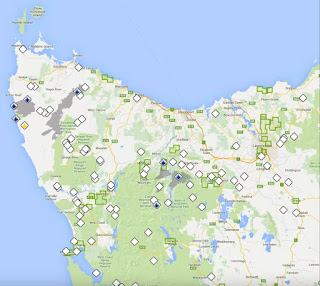Comments welcome.
***********
Thank
you asking me to speak today, and for that introduction. I
was trained in medicine, and did my internship here at the LGH
(Launceston General Hospital). But I was always interested in global
public health, and I've been lucky enough to largely be employed in
that field.
I first became aware of the risks to public health from climate change in 1989, when I read an editorial in the The Lancet, one of the world's most respected medical journals. It warned that climate change could "reduce crop production, with potentially devastating effects on world food supplies". It also stated that "armed conflicts would be more likely as countries compete for a dwindling supply of natural resources".
It stated that "diseases hitherto confined to the tropics may spread to higher latitudes as global temperatures increase, and vector-borne diseases will become more widespread". Some of you will have heard that the disease Japanese encephalitis, which is transmitted by mosquitoes, has recently been detected for the first time on several mainland states, and has killed several people, including in Victoria. Until last year, this disease was confined (in Australia) to islands in the Torres Strait - the reasons for its spread so far south are unclear, but may be related to the widespread heavy rain in Queensland and NSW, and perhaps to altered bird migration due to this rain. This is plausible as some water birds can carry this disease, as well as pigs. Now that it has reached the southern mainland states it is likely to be very hard to eliminate - many Australians will probably end up having to get the vaccine for Japanese encephalitis, a disease which can not only kill, but also leave survivors with disabling neurological illness.
We all know the cost of living is outpacing income growth, and is especially hard for people on fixed incomes. Although the main reason for more expensive food is the rising cost of oil and the war in Ukraine (which is a major wheat exporter) a lesser known reason is climate change. If temperatures are too high, not only are humans harmed, but also animals and crops. Then there are floods. In 2019 as many as 600,000 cattle drowned from floods in north Queensland. This year, floods around Lismore and southern Queensland have affected almost as many stock - close to half a million. This loss adds to food prices, as well as causing great distress to farmers and animal lovers. Unfortunately, the cost of food is likely to rise again, even after the Ukraine war ends, and even if the price of energy falls - which, over the long run, is only plausible if renewable sources of energy are greatly increased. It's sometimes hard to imagine, but we are only in the early stages of climate change - unless there is emergency action to bring it under control. Such actions should be led by wealthy countries such as ours; we should set an example.
The mainland is getting hotter - maximum temperatures in parts of western Sydney, where I went to school, are already nearing 50 degrees C. The mainland is also experiencing increasingly severe floods, droughts, bushfires and coastal erosion.
Tasmania, of course, is not immune to these problems. In June 2016 there was widespread flooding in many parts of Tasmania; it was termed a national disaster and claimed three lives, including someone from Evandale. It was also very expensive, including for local councils to repair roads and bridges. Many of you will also remember the fires here in the summer of 2016, including in the high country. (See figure, from "Fires in Tasmania’s ancient forests are a warning for all of us" by Prof David Bowman.)
The summer of 2015-6 was the hottest so far, on record. Summers are getting warmer and drier. This makes me apprehensive for the long term viability of our magnificent native forests.
Bad as things are here from human-driven climate change, many parts of the mainland and overseas are even more vulnerable. There is no doubt that climate change is already a major driver of migration into Tasmania. This influx of people and money is welcomed by many, but it also creates many challenges, particularly by increasing inequality. I believe that is a factor in the increasing problem of homelessness.
My last point concerns the mental health effects of climate change. There is no doubt that this is a topic that provokes anxiety. It leaves us two choices – to try to ignore it, or to try to do something about it. I’m sure most of you want to do something about it – that’s why you’re here. Although it’s important to not burn out from trying too hard, evidence exists that shows that getting involved in making the energy and sustainability transitions - such as by involvement in community gardening - is helpful psychologically, as well as a healthy strategy for our beautiful planet.
Thank you for listening.


